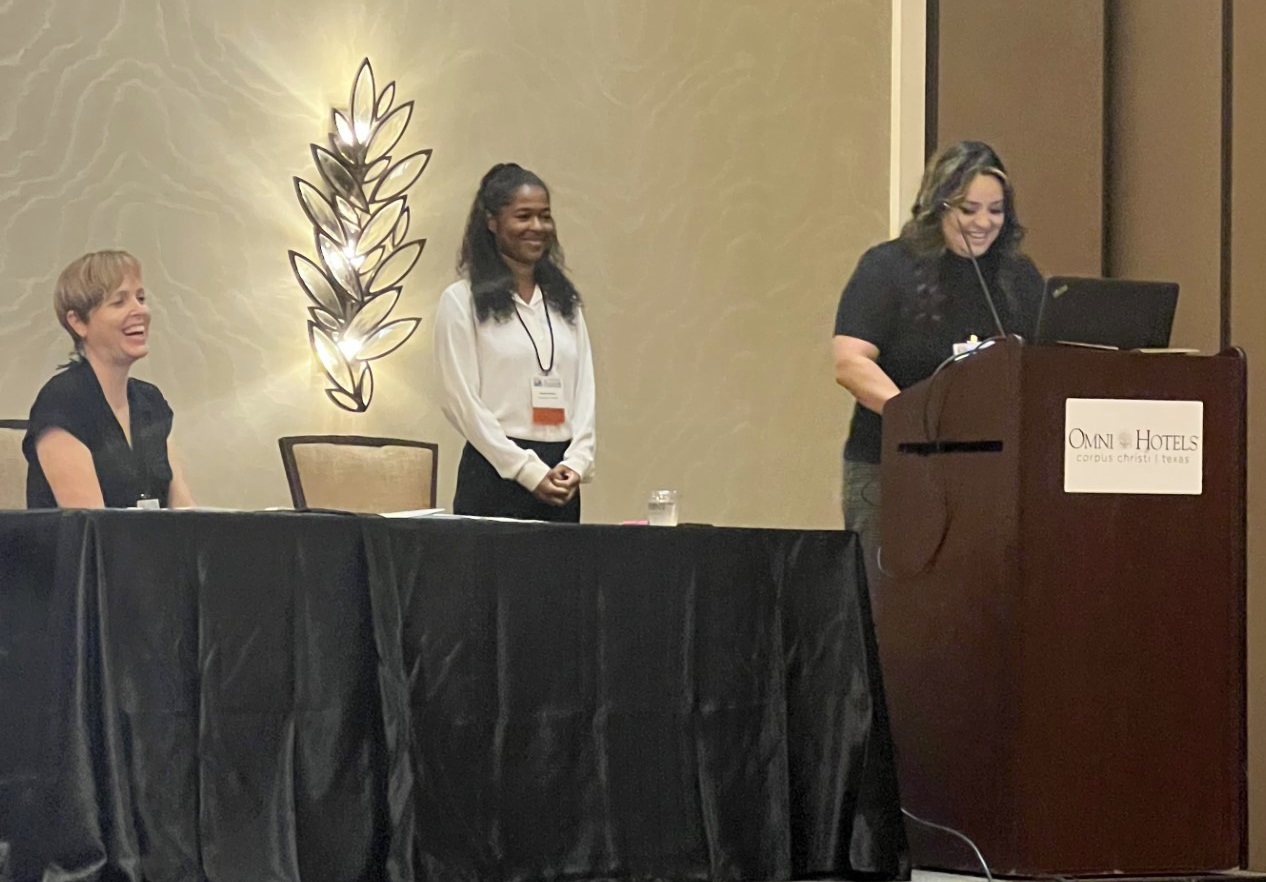Southeast conservation lands of the future – SECAS at SEAFWA 2023
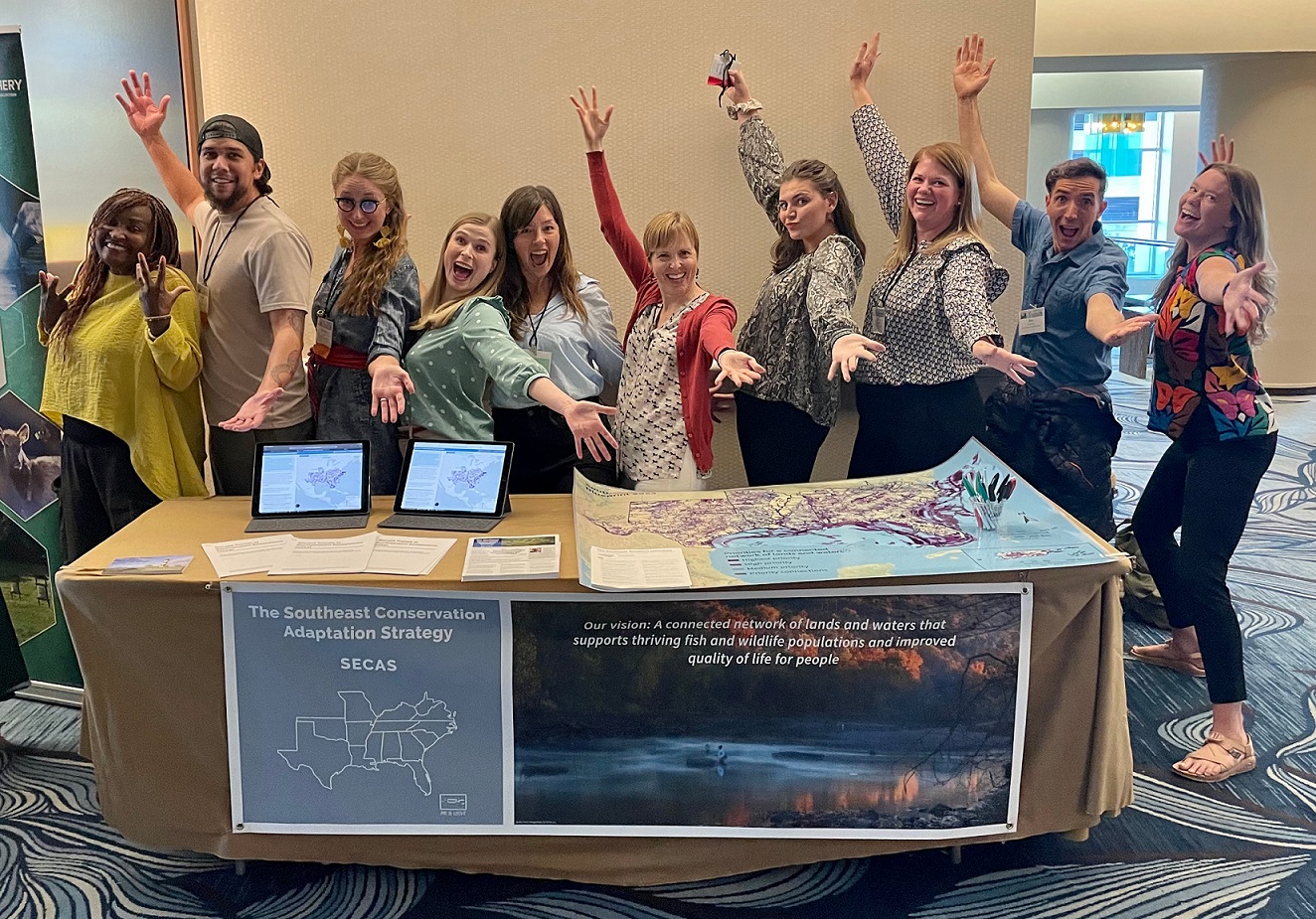
It was a big week for SECAS at last month’s Southeastern Association of Fish and Wildlife Agencies conference. As in previous years, SECAS released the newest versions of the Southeast Conservation Blueprint and the SECAS Goal report. This year’s updates included updating and expanding the Blueprint in the U.S. Caribbean and Gulf of Mexico marine environment, as well as other refinements. SECAS staff worked hard to finalize the Blueprint and the Goal report before the conference as well as organizing and facilitating several symposia, giving five presentations, participating in panel discussions, connecting with partners at our booth, and reporting to the SEAFWA Board of Directors.
For me, some of the conference highlights were working alongside this year’s Minorities in Natural Resource Conservation (MINRC) student fellows, reporting to the SEAFWA Board of Directors, participating in the Caribbean Community of Practice symposium, and hosting the annual SECAS symposium. On behalf of the official SECAS joint-party subcommittee of SEAFWA, I updated State Directors on key SECAS accomplishments for the year and showcased the work of SECAS staff to support other subcommittees, such as the Southeast Aquatic Resources Partnership (SARP) and MINRC. A big achievement came during the Directors’ Business Meeting, where the SEAFWA Directors unanimously adopted the SECAS Charter, which outlines the SECAS governance structure and the duties of the Executive Steering Committee.
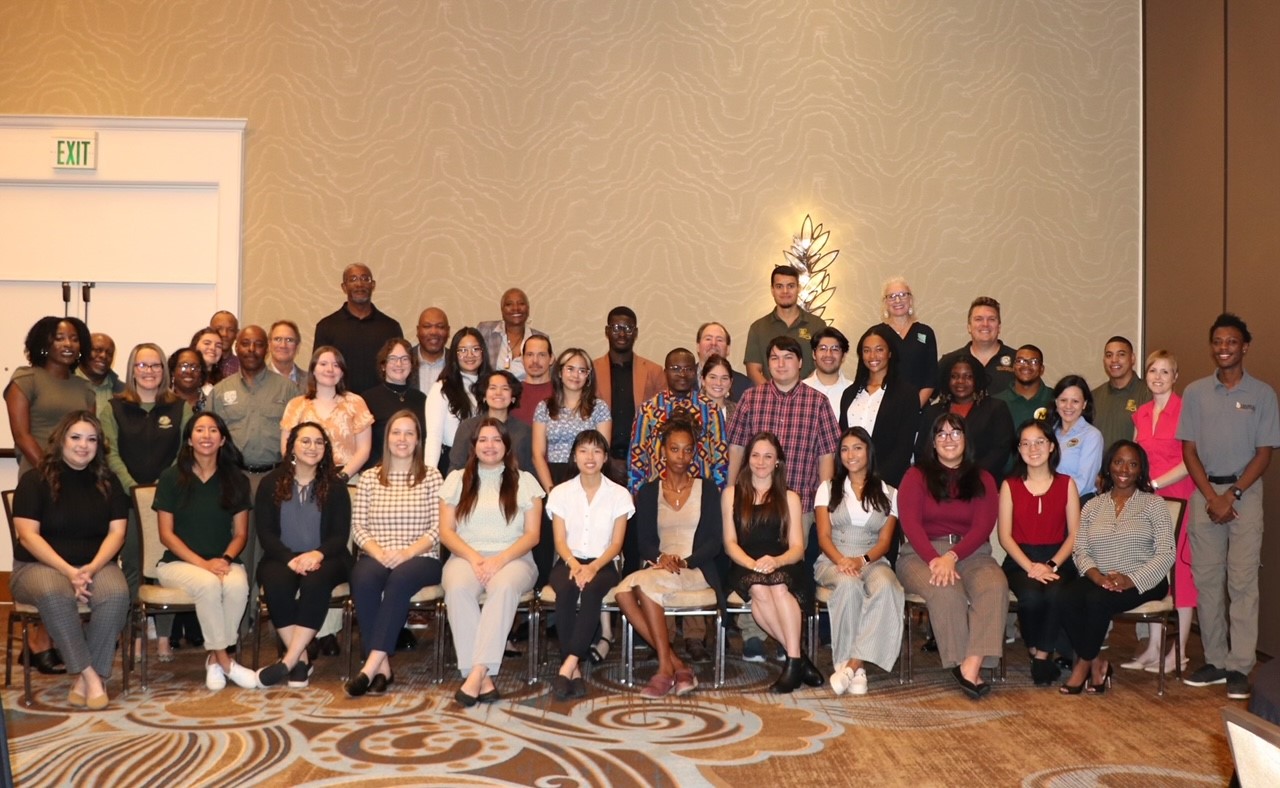
I am proud of the support SECAS staff provided to help organize and moderate a symposium supporting the Caribbean Conservation Community of Practice (CCoP), entitled A Caribbean Community of Practice to Benefit People and Fish and Wildlife Resources. The CCoP, which is composed of community leaders, researchers, universities, non-profits, as well as federal, state, and territorial governments working in the Caribbean, is advancing conservation planning, action, and research in the region. Partners are working together to build an applied science and resource management network, helping address data inequities and the historic marginalization of Caribbean communities. So far, 90+ people from 30+ different organizations are participating in this network.
The Caribbean is home to diverse habitats and species, as well as important historical and cultural resources. During this symposium, researchers and conservation partners working in Puerto Rico and the U.S. Virgin Islands discussed the area’s complex social and natural dynamics, defined by natural and anthropogenic reductions in ecological connectivity, unique endemic wildlife and plants, centuries of natural resource exploitation, and a rich culture. Speakers addressed regional priorities and local actions, including identifying science priorities, increasing the resilience of coastal habitats and communities, conserving rare plants, restoring freshwater ecosystems, assessing potential climate impacts, the impacts of urbanization on beaches, and improving acoustic biodiversity monitoring. The presentations and subsequent panel discussion underscored the needs and opportunities for working collaboratively and developing interdisciplinary responses to these natural and societal challenges.
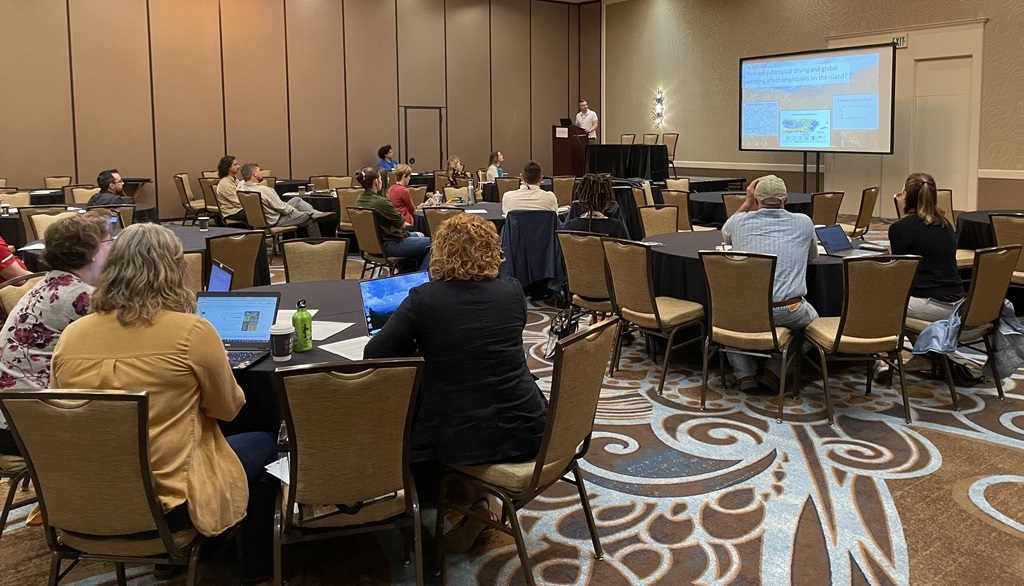
While the SECAS symposium is always an important event for SECAS, this year may have been our best so far! Entitled Southeast Conservation Lands of the Future – collective action towards a sustainable landscape, our symposium centered around how all partners in the Southeast have a role in achieving the shared SECAS vision: a network of connected lands and waters that support thriving fish and wildlife populations and improved quality of life for people. Working with diverse sectors of the economy is an important step and part of a multi-tiered approach to make this vision a reality.
Symposium speakers highlighted how the Blueprint and the SECAS partnership are helping support not only positive ecological outcomes, but positive economic outcomes.
-
Leo Mirando-Castro, Conservation Without Conflict – Environmental and societal benefits of shade-grown coffee: As the owner and manager of a shade-grown coffee farm in Puerto Rico, Leo discussed the many benefits of shade-grown coffee, such as improving water quality and providing important habitat for plants and wildlife, including endangered, threatened, and at-risk species. In Puerto Rico, shade coffee plantations have played a critical role in preserving biodiversity by offering habitat corridors and buffers, protecting healthy soil ecosystems, and reducing sedimentation during a period when the landscape suffered from severe deforestation. They serve as a model for other agricultural and forestry settings, promoting the conservation of a healthy local economy and ecosystems while keeping working lands productive. Shade coffee is an important feature of the Caribbean reforestation potential indicator in the 2023 Southeast Conservation Blueprint that helps partners identify highest priority lands to maintain a connected network of lands and waters.
-
Dr. Sandra Thompson, South Carolina State University – Using the Blueprint to communicate the natural resource benefits of a cultural heritage trail: Sandra is the founder of North Star Legacy Communities (NSLC), a nonprofit working to elevate community resiliency by recognizing, celebrating, and preserving African American cultural heritage and history. Sandra and Louise Vaughn, a SECAS Blueprint user support specialist, shared how the Blueprint helped demonstrate the positive ecological impacts associated with a proposed Black heritage trail in the Florida Panhandle, and helped justify the project to funders. This cultural interpretation trail, which was successfully designated as a Land Trail Opportunity in Florida, celebrates the history and culture of African Americans in the Panhandle and connects to the wider regional trail network. This presentation showed how NSLC is working with partners to increase conservation, recognition of cultural assets, and economic opportunities within the Florida Panhandle to better align with a regional recreation-based economy.
-
Amy Gutierrez, The Nature Conservancy – Using the Blueprint to inform renewable energy siting in Georgia: As the Climate and Lands Coordinator at The Nature Conservancy (TNC), Amy focuses on climate and stewardship issues in the state of Georgia and pioneered the development of the Georgia Low Impact Solar Siting Tool (GA LISST). While rapid deployment of large-scale solar energy projects is critical to accelerate the transition to a cleaner energy future, these projects often require significant quantities of land and cause significant habitat destruction and runoff. TNC is working with partners to responsibly site solar projects, both protecting sensitive habitats and providing more certainty for developers by avoiding delays and public opposition. Collaborating with conservation groups, developers, and utilities, TNC launched the GA LISST to help support decision-makers seeking win-win outcomes for conservation and decarbonization by identifying sensitive areas at greatest risk for conversion and highlighting opportunities for solar development in areas of lower environmental impact. The GA LISST incorporates a broad suite of input datasets—including the Blueprint. Partner engagement and datasets like the Blueprint have been critical for developing defensible and partner-supported rankings for both environmental sensitivity and solar suitability across Georgia, which ranks as one of top 10 states for the yearly rate of new solar installations.
-
Sean Kelly, U.S. Virgin Islands Division of Fish and Wildlife – Using the Blueprint to plan and create equitable parks and protected areas: Sean is a wildlife biologist at the USVI Department of Planning and Natural Resources. He and many colleagues are using the Southeast Blueprint and input from a wide range of stakeholders in the Caribbean to create new parks and trails. The Territorial Parks System was signed into law in August 2022 and the SECAS team helped support a key acquisition project on St. Croix that will contribute to the parks system. This property will serve as a hub for a new expansive trail project proposed for the island that will connect important places around the island for people and nature. These initiatives will support the local economy through nature-based tourism, sustainable fisheries, and public access, and will create the first hiking trail through public and private lands ending at two priority restoration sites. Each trailhead will be a point of access to the trails, solar energy chargers (cars, batteries) and trash receptables, and a point of sale for parks passes and recreational fishing licenses. The buffers around the trails will serve as conservation corridors connecting northern and southern coasts, wetlands to freshwater streams, and important breeding habitat for American eels, migratory birds, and more. At each stage of the project development, Sean pointed out the importance of the Blueprint in justifying the ecological benefits and communicating and the regional significance and scientific justification to project funders.
-
Jay Hayek, Drax – Drax’s ambitions to achieve nature-positive outcomes: Jay is a Forest Nature and Conservation Manager with Drax, a renewable energy company with a strong commitment to sustainability. Drax has committed to delivering tangible nature-positive outcomes through their biomass sourcing and by partnering with conservation groups, federal and state agencies, the scientific community, and other members of the forest products sector. Drax is seeking opportunities to include sources of woody biomass that, if properly removed from the forest, would enhance ecosystem conditions. Drax plans to use the Blueprint and work with SECAS staff to help prioritize and develop these strategies.
Following the presentations, a panel discussion comprised of select presenters and SECAS Steering Committee Members discussed future directions for the SECAS partnership, focusing on long-term sustainability of the southeastern landscape. The panelists fielded thought-provoking questions such as:
- Will we recognize the Southeast in 100 years?
- What role should green energy play in the landscape of the future?
- If the If the Blueprint is wildly successful, how do you see the Blueprint influencing green energy decisions?
- How do we engage a wide range of conservation professionals and technical experts to develop and buy into a model of collective action?
- How do we ensure a vitality of life for people, including underrepresented communities, while meeting the need of fish, wildlife, plants, and their habitats?
- How are the panelists working to better incorporate diversity in their organizations?
- How can we better incorporate working lands in meeting both ecological and economic outcomes?
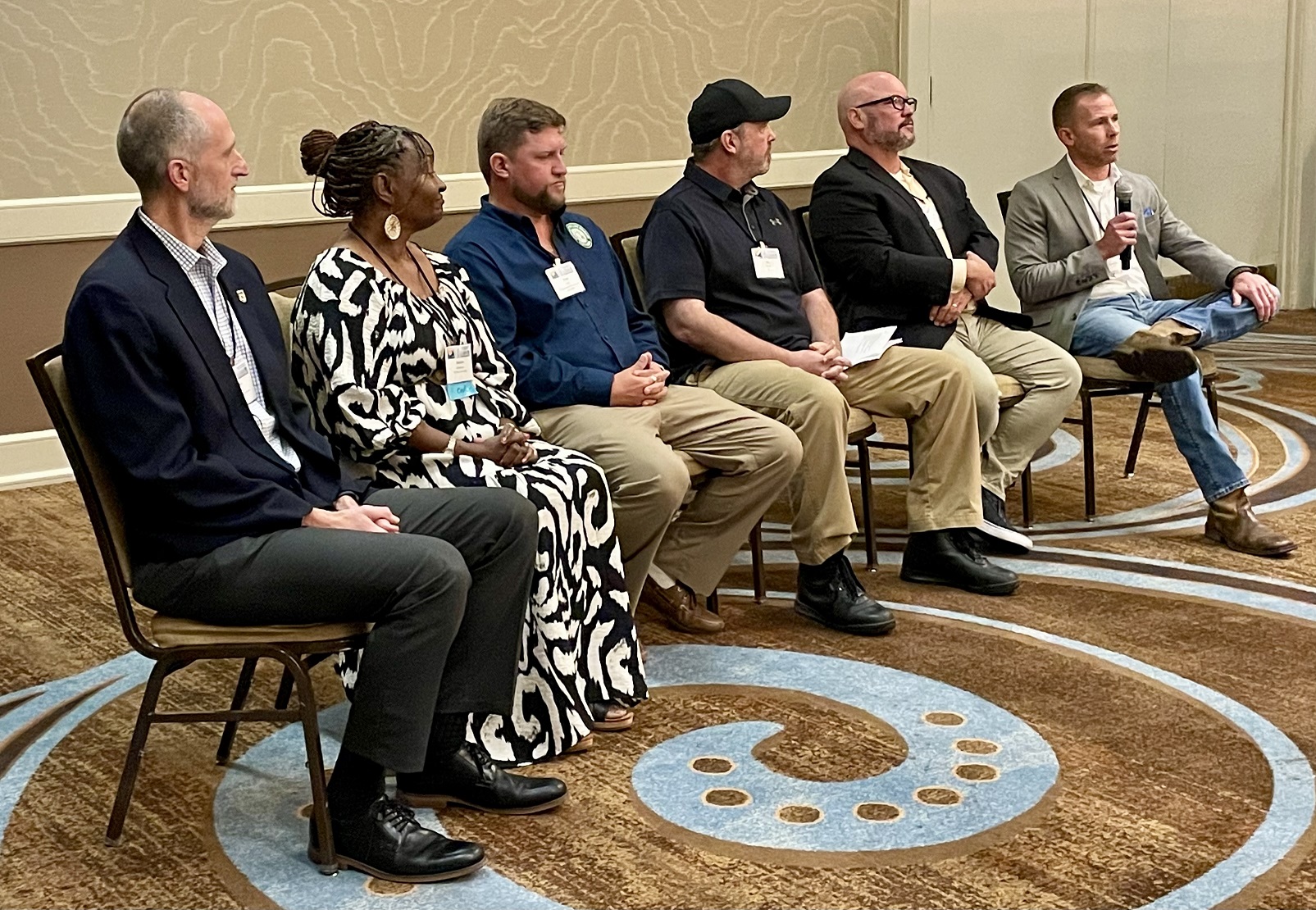
This panel discussion set the stage for continued dialogue within the partnership to guide future strategic direction, identify opportunities for voluntary, landscape-scale collaboration, and address barriers for working across organizational boundaries.
The symposium was skillfully moderated by 2022 MINRC fellows Tanya Duran and Jaiere Harlow. Both Tanya and Jaiere are currently graduate students in the Southeast.
